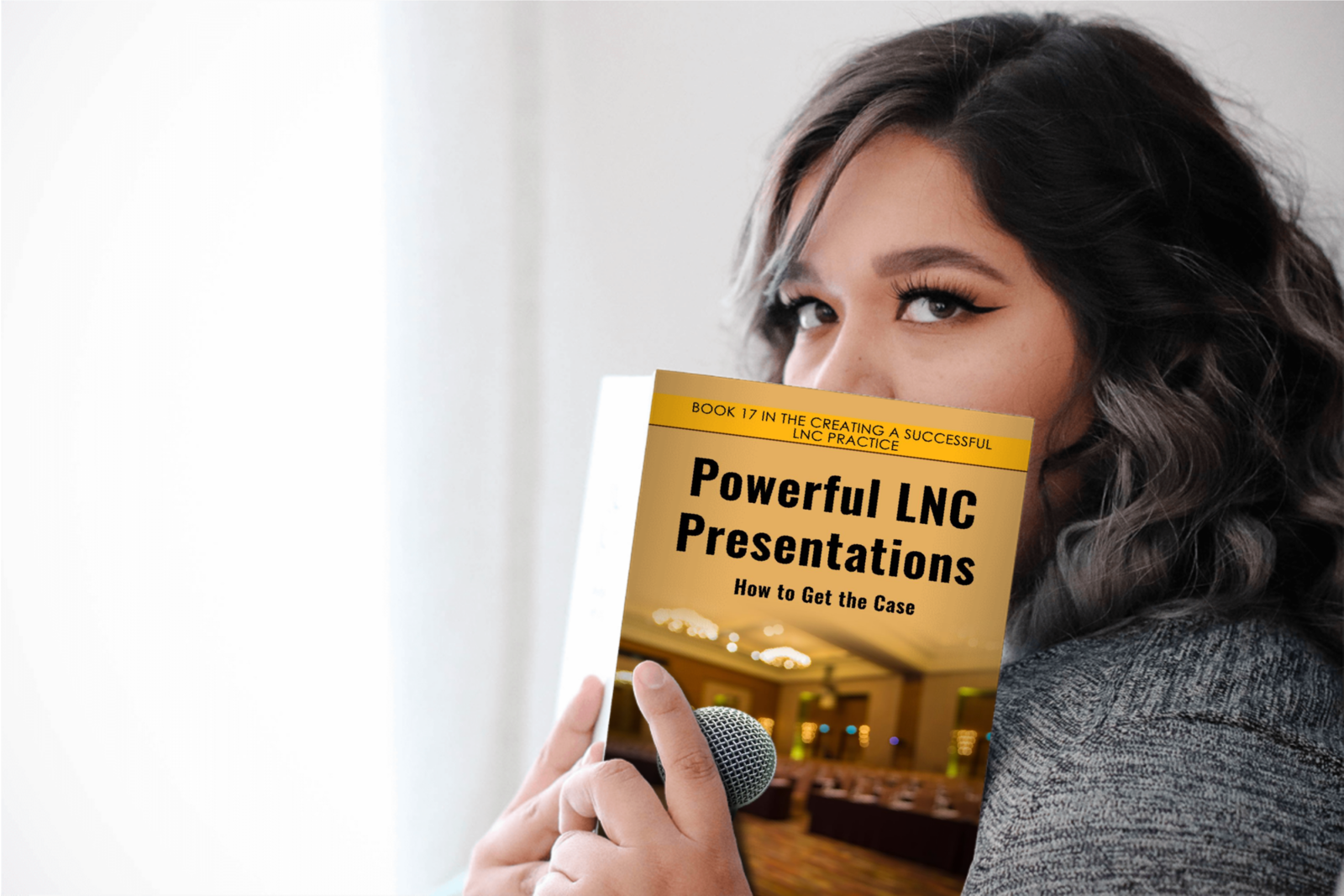Plan Your LNC Presentations for Attorneys
You receive an invitation to speak to attorneys. Time to plan your LNC presentations.
LNC Presentations: The Basics
When you find out you’ll be presenting to attorneys, it’s time to start planning.
Ask the person who is your liaison about the attendees:
- What type of attorneys will be in the audience?
- What practice areas do they represent?
- What type of medical records do they handle?”
Please don’t make assumptions about the audience, thinking they all handle medical malpractice cases.
What does the planning committee want you to cover, if there is one? How deeply can you go into subjects? How much time is available for your talk?
- Where will you be presenting?
- What type of visual aids can you use?
- What technology will be available to you?
- Knowing this information will help you make your presentation the right one at the right time for the right audience.
I’ve assembled a handy free checklist, Presentation to Attorneys Checklist, which will ensure you do not overlook any aspect of getting ready for and delivering your presentation. Go to this link to request the Presentation to Attorneys Checklist.
Interactive LNC Presentations for Attorneys
Plan how to make your presentation interactive. You have an opportunity to give a presentation to attorneys. A lot of attorneys lecture their colleagues. I’ve heard so many attorneys complain that these presentations are boring. How can you craft interactive presentations for this kind of audience?
More than questions and answers
Interactive presentations are much more interesting because they engage the audience. Go beyond simply having a Q& and A session by asking for questions and comments. Attorneys may not have a question, but they may have something they want to share or like to comment on something you told them.
After you decide you will have a Q and A session, determine whether you will integrate it as part of your talk or save it for a particular segment of your speech.
Any time you plan interactive presentations for attorneys, think about what will result in engagement. You want attorneys to get emotionally connected with what you’re saying.
Keeping your attention on your audience is necessary to encourage engagement or interactivity. Suppose you’re doing a Q and A session and say, “I’d love to entertain some questions or comments that you may have.” In an in-person event, look out at people. If you drop your eyes even for a second, people think you are insincere, and they will not step up and ask questions.
Interactive Activities for In-Person Events
Colored dots
Give colored dots to people who ask questions. It’s amazing how adults love to be competitive about how many dots they collect. Depending on the number of dots at the end of the session, you may give them an award or a giveaway.
Small group discussion
Divide the group into groups. Give people an assignment and say, “Just turn to the right, talk to the person next to you,” and give them a question to share among themselves. It can be a Q and A where just one person stands up and asks questions or makes a comment. It can even be small group work where you ask people to turn to the neighbor or get in groups of three and give them something to do like answer a question or generate some thoughts about a particular topic.
When I taught attorneys a program about medical records, I asked them, “Turn to the person next to you and discuss what aspect of working with medical records you find most challenging.” When they were finished, I asked them to share their answers. As I continued my talk, I wove in those problems and shared some solutions.
Ball toss
Bring soft foam balls and recruit someone to help you with this activity. Ask a question and request audience members to raise their hands if they know the answer. Look for the person who raised their hand first. Have your helper toss the ball (which the attendee keeps if they got the answer right) before the attendee answers. I deliberately start with easier questions to get the engagement. Seven to ten questions are enough.
Adding the ball toss increases the energy of this activity. And a word of caution. This technique works well when attendees sit in front of narrow tables and the person tossing the ball is an accurate thrower. It is a bit more awkward when the attendees have glasses or plates in front of them for a luncheon meeting. When I tried this technique in that room, water glasses flew.
Simulation
Bring props with you to simulate a condition. For example, using my knowledge of the aging simulation, I took a group of plaintiff attorneys who litigated nursing home cases through an aging simulation. Next, I divided them into groups and deprived them of their senses.
- Loss of hearing: Some put in earplugs and had to listen to instructions.
- Dependence: Some fed a blindfolded colleague.
- Sight: I handed out prescription glasses or glasses smeared with Vaseline, which they had to wear and walk around the room.Mobility: I passed out knee braces.
- Respiration: Some had to breathe through straws to simulate COPD.
And some even put on diapers.
After the simulation part was over, I led the attendees in a debriefing session to discuss how the experience changed their perspective on aging. This activity was a huge success.
My most successful program
My client and I did a role-play in front of an audience of about 30 plaintiff attorneys.
Here is how it came about:
My client represented a woman who was hit by a bus returning from gambling in Atlantic City. She incurred extensive injuries, from which she recovered. When the defense attorney took her deposition, she consistently downplayed the impact of the injuries on her life. The attorney came to me to provide him with an expert fact-witness summary of her medical records.
After seeing the summary, the defense increased the size of its offer from $200,000 to one million dollars.
At the beginning of our ten-minute segment, I put on a scarf to cue the audience that I was playing the plaintiff. The attorney and I read the brief segments of the deposition during which the plaintiff minimized her injuries. Then I turned to the audience and said, “Garry called me and said, ‘Pat, we have a problem.’” The audience roared in laughter.
I then explained the role of the expert fact witness in summarizing injuries and treatment. When I stepped down, I had a line of attorneys waiting to ask for my card. That one presentation resulted in $250,000 in income.
There are so many techniques for creating interactive presentations for attorneys. These are just a few to get you thinking.

Interactive Activities for Online Presentations
With it being too easy to turn off the camera, your attendee needs an incentive to stay engaged. As we spend more time in front of monitors, our need for interactivity increases. Here’s how to keep them interested.
Plan on some interactive activity every 7-10 minutes.
Polls: Provide the program moderator with questions you’d like attendees to answer. These need to be preloaded into Zoom before the event starts. Give attendees sufficient time to respond to the poll before reviewing the results.
If you have two questions, have the answer for the first one be 1, 2, 3, and for the second one A, B, C. That way, you can differentiate the answers. Alternatively, ask the attendees to respond by putting a short answer into chat.
Breakout rooms: Ask the host to prepare breakout rooms and send the attendees into a room with a specific assignment.
Unmute and answer questions: Give attendees an option to ask questions.
Acknowledge attendees by name. This effort keeps them alert because they don’t know when you will say their name. You might say, picking a name randomly, “Suppose José got a case involving a slip and fall.” José will take notice as well as others watching this interaction.
Be sure to get my latest book in the Creating a Successful LNC Practice Series, Powerful LNC Presentations: How to Get the Case.

Pat Iyer is president of The Pat Iyer Group, which develops resources to assist LNCs in obtaining more clients, making more money, and achieving their business goals and dreams.
Pat’s related websites include the continuing education provided on LNCEU.com, the podcasts broadcast at podcast.legalnursebusiness.com, and writing tips supplied at patiyer.com.
Get all of Pat’s content in one place by downloading the mobile app, Expert Edu at www.legalnursebusiness.com/expertedu. Watch videos, listen to podcasts, read blogs, watch online courses and training, and more.



